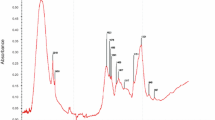Abstract
It is very important to minimize the secondary waste generation for the decontamination of the primary coolant system. The SP-HyBRID process can obtain a similar decontamination performance to the HP CORD UV process. The SP-HyBRID decontamination wastewater can be purified by a precipitation process using Ba(OH)2, and the waste generation can be greatly reduced. For this reason, removal tests of impurities in a SP-HyBRID decontamination wastewater surrogate were conducted using the precipitation process. As the results, the impurities in the surrogate were effectively removed, and the waste generation was reduced by 60% when compared with the HP CORD UV process.




Similar content being viewed by others
References
Wood CJ (1990) A review of the application of chemical decontamination technology in the United States. Prog Nucl Energy 23(1):35–80
Bradbury D (2000) Review of decontamination technology development 1977–2000, Water chemistry of nuclear reactor systems 8, BNES, London
Riess R, Odar S, Kysela J (2009) Decontamination and steam generator chemical cleaning. Advanced Nuclear Technology International, Sweden, Skultuna
Kim SB, Won HJ, Moon JK, Choi WK (2016) Magnetite dissolution using hydrazine-acid solution for chemical decontamination, vol 115. Transactions of the American Nuclear Society, Las Vegas
Choi WK et al (2016) Development of decommissioning, decontamination, and remediation technology for nuclear facilities: development of advanced decontamination technology for nuclear facilities. Korea Atomic Energy Research Institute, KAERI/RR-4230/2016
Bologo V, Maree JP, Carlsson F (2012) Application of magnesium hydroxide and barium hydroxide for the removal of metals and sulphate from mine water. Water S Afr Water Res Comm 38(1):23–28
Scholz F, Kahlert H (2015) The calculation of the solubility of metal hydroxides, oxide-hydroxides, and oxides, and their visualisation in logarithmic diagrams. ChemTexts 1:7
Blais JF, Djedidi Z, Ben Cheikh R, Tyagi RD, Mercier G (2008) Metals precipitation from effluents: review. Pract Period Hazard Toxic Radioact Waste Manag 12(3):135–149
Pang FM, Teng SP, Teng TT, Mohd Omar AK (2009) Heavy metals removal by hydroxide precipitation and coagulation flocculation methods from aqueous solutions. Water Qual Res J Can 44(2):174–182
Rene ER, Sahinkaya E, Lewis A, Lens PN (2017) Sustainable heavy metal remediation volume 1: principles and processes, environmental chemistry for a sustainable world. Springer, Basel
Ayres DM, Davis AP, Gietka PM (1994) Removing heavy metals from wastewater. University of Maryland, College Park
Crear R (2001) Engineering and design precipitation/coagulation/flocculation. US Army Corps of Engineers, Washington
Ngatenah SNI, Kutty SRM, Isa MH (2010) Optimization of heavy metal removal from aqueous solution using groundwater treatment plant sludge (GWTPS). In: International conference on environment
Thomas M, Zdebik D, Białecka B (2018) Using sodium trithiocarbonate to precipitate heavy metals from industrial wastewater—from the Laboratory to Industrial Scale. Pol J Environ Stud 27(4):1753–1763
Fenglian F, Wang Q (2011) Removal of heavy metal ions from wastewaters: a review. J Environ Manag 92:407–418
Topf C, Sempere-Belda L, Tscheschlok K, Reuschle K (2014) Aqueous, in situ primary circuit decontamination. Nucl Eng Int 59(718):16–18
Park SY, Won H-J, Choi M-S, Kim SB, Choi W-K, Moon J-K (2017) Waste minimization of HyBRID decontamination process. In: Waste management conference, Phoenix, AZ, USA
Schecher WD, McAvoy DC (1992) MINEQL+ : a software environment for chemical equilibrium modeling. Comput Environ. Urban Syst 16:65–76
Ronie A (2002) Outokumpu HSC chemistry for windows. OutoKumpu Research, Pori
Pourbaix M (1974) Atlas of electrochemical equilibria in aqueous solutions. National Association of Corrosion Engineers, Cebelcor, Houston
Efremenkov VM (1989) Radioactive waste management at nuclear power plants. IAEA Bull 31:37–42
Radiation protection standards in Korea, No. 2017-36
Basak NN (2003) Environmental engineering. Tata McGraw-Hill Education, New York City
Acknowledgements
The authors would like to express their appreciation to the National Research Foundation of Korea (NRF) for the award of a grant funded by the Ministry of Science, ICT and Future Planning (MSIP) of the Republic of Korea, in support of the authors’ work through the Nuclear Research and Development Program (NRF-2017M2A8A5015144).
Author information
Authors and Affiliations
Corresponding author
Rights and permissions
About this article
Cite this article
Jung, J.Y., Eun, H.C., Park, S.Y. et al. A study on the removal of impurities in a SP-HyBRID decontamination wastewater of the primary coolant system in a pressurized water reactor. J Radioanal Nucl Chem 318, 1339–1345 (2018). https://doi.org/10.1007/s10967-018-6219-0
Received:
Published:
Issue Date:
DOI: https://doi.org/10.1007/s10967-018-6219-0




